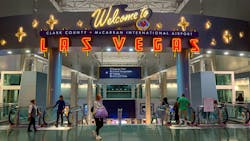Self-service TSA screening is being tested in Las Vegas. Here's how it works
LAS VEGAS - Imagine this: You make your way through the airport security line, send your bags through the scanner, empty your pockets and go through a body scanner — all with little to no interaction with a TSA agent, Michael Salerno writes for USA Today. Continue reading original article.
The Military & Aerospace Electronics take:
11 March 2024 - The Transportation Security Administration (TSA) and the Department of Homeland Security (DHS) Science and Technology Directorate (S&T) unveiled a prototype checkpoint technology, the self-service screening system, at Harry Reid International Airport (LAS) in Las Vegas. TSA PreCheck® passengers at TSA’s Innovation Checkpoint will be the first travelers to have the option to use the new system starting in mid-March, when the testing begins. The same rigorous screening standards and rules required of passengers using the TSA PreCheck lanes apply to the self-screening lane.
The self-service screening system is a prototype technology that TSA and S&T designed, developed and tested initially in a laboratory setting at the TSA Systems Integration Facility in Arlington, Virginia. The prototype has a video monitor that provides step-by-step instructions for passengers to complete screening at their own pace. Once passengers have completed the required screening process and are cleared for travel, automated exit doors open so travelers can gather their belongings and head to their flights. While there is minimal assistance from Transportation Security Officers (TSO), TSOs will be available for assistance as needed. TSOs will work to ensure TSA PreCheck passengers using the self-screening lane are following security protocols. The aim is to provide a near self-sufficient passenger screening process while enabling passengers to directly receive on-person alarm information and allow for the passenger self-resolution of those alarms to reduce instances where a pat-down or secondary screening procedure would be necessary.
Related: TSA chief says biometrics and tech could lower the stress of traveling
Related: TSA issues new cyber security requirements for airport and aircraft operators
Jamie Whitney, Senior Editor
Military + Aerospace Electronics
